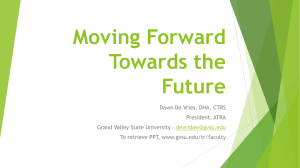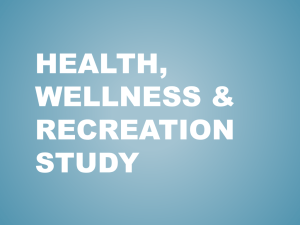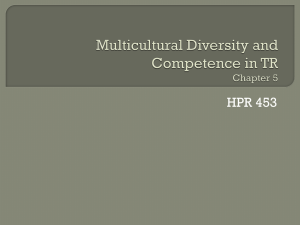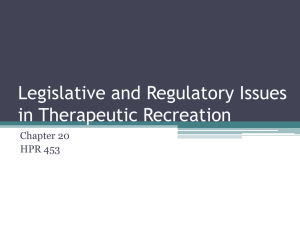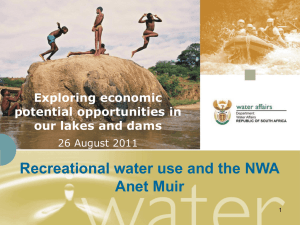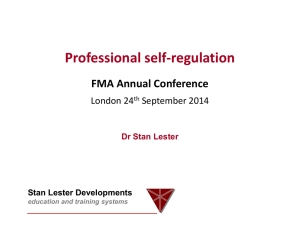Strategies for Growing Your Profession
advertisement
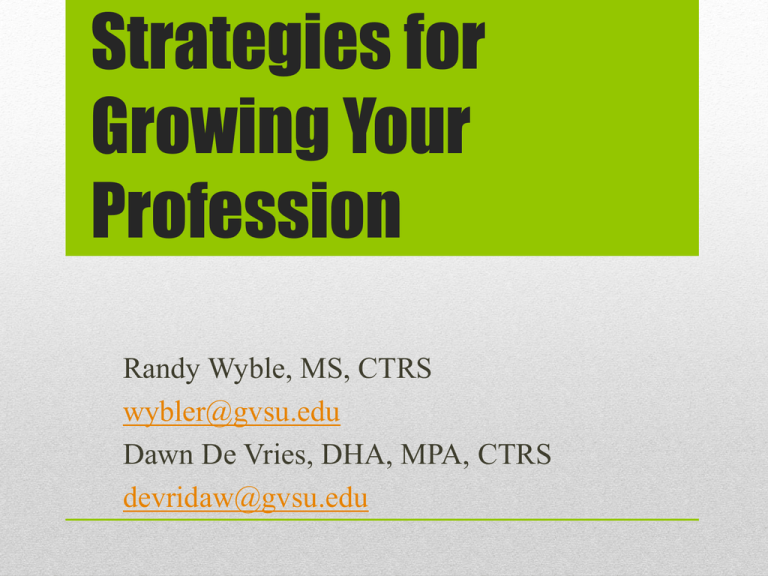
Strategies for Growing Your Profession Randy Wyble, MS, CTRS wybler@gvsu.edu Dawn De Vries, DHA, MPA, CTRS devridaw@gvsu.edu For a copy of this PowerPoint, go to: gvsu.edu/tr Click on the faculty link to the left and it will be listed in our faculty sketches. • Participants will identify 2 strategies to become active members and professionals. • Participants will state 2 qualities of professional membership that they value. • Participants will express 2 techniques to grow the TR field. Learning Objectives 1. 2. 3. 4. 5. 6. 7. Introductions Personal: Where are you in valuing the TR profession? Yesterday: Where have we been? Today: Where are we now? Tomorrow: Where do we want to be? Strategies: How do we get there? Wrap Up Session Outline PROFESSIONAL EXCITEMENT QUIZ When the most recent issue of Annual in Therapeutic Recreation becomes available online, I …. A. laugh... What is Annual in Therapeutic Recreation Journal? B. Delete the message. C. Bookmark it; I’ll get to it later. D. Skim the Table of Contents to see what’s in it. E. Read it ferociously to gather pertinent information. I am presently a member of… A. B. C. D. E. Nothing, other than my family. Rotary Club or similar service organization. A local recreation therapy group. A state recreation therapy group. At least one national and state recreation therapy organization. For my own continuing education, I A. B. C. D. E. Sleep. Read People Magazine. Watch PBS. Attend a conference every few years. Attend local, state or national workshops/ conferences annually When I hear about budget cuts that may have an impact on recreational therapy, I ... A. B. C. D. E. Pray I finish my MBA soon. Stock up on food and store it in my basement. Complain about the system. Talk to other professionals about the issue. Write to local, state or federal legislators. Getting a degree in recreational therapy… A. B. C. D. E. Was a waste of time. Lacked foresight. Enables me to help people. Was necessary for professional employment. Allows me to promote the use and value of what I do. I know I am delivering quality recreational therapy services because: A. B. C. D. E. My significant other tells me so. My clients tell me so. I just know so. Okay? My boss/co-worker tells me so. I have established a system for continuous process improvement that tells me so. The future of recreation therapy… A. B. C. D. E. What future? It is non-existent. Relates to the future of all allied health professions. Depends upon my agency. Depends upon our leaders. Depends upon me. SCORING OF THE PROFESSIONAL EXCITEMENT QUIZ • You may score your quiz in the following manner: A = 1 Point B = 2 Points C = 3 Points D = 4 Points E = 5 Points • After you have coded each question, add your points for a total score. The following scores are presented as a summary of your results on the Professional Excitement Quiz. You are majorly excited about your profession just about 24 hours per day. You eat, sleep, and breath recreational therapy. Some even call you a recreation therapy geek. You wear your ATRA button and ATRA pens along with your calculator in your shirt pocket. You network daily with other recreational therapists and consider yourself a "web site" for other professionals. You've been heard using such high tech RT language as: CQI, outcomes, TPO, CMS, and “e-mail me at therapist @RT.com." You read all the standards manuals and professional journals for the latest trends and developments. 45-50 Total Points You are still excited though you take breaks for major bodily functions. You have ATRA buttons and pens but keep them in your briefcase. You network with other recreational therapists and have a keen professional awareness in locating recreational therapy websites. Your high tech RT vocabulary includes QA, TPO, and outcomes. You know where to find the standards manuals and professional journals and read them occasionally. 40-44 Total Points You're occasionally on and occasionally off in being excited about recreational therapy. You've been somewhat involved in professional organizations and have dabbled with networking with other professionals, though your networking is low tech and passive. Your RT tech vocabulary includes words such as programming, evaluation, and marketing. You know where to find the standards manuals and journals. You even know what a policies and procedures manual looks like. 35-39 Total Points You're more off than on when it comes to being excited about the profession. This may be your first recreational therapy networking opportunity and you are learning how to connect with other recreational therapists. Your RT tech vocabulary includes words such as sports, crafts, and sandbox. This may be the first you've heard of standards manuals, and professional journals are just too much trouble to read. 25-34 Total Points You are off line. You wandered into this conference by accident because Maryland was on your ten favorite U.S. states list and your agency paid. Your RT vocabulary includes words such as “See Spot Run”. You devalue RT opting instead for food, sleep, and Monday night football. Your journal exposure is limited to Reader’s Digest, Sports Illustrated, and People Magazine. 15-24 Total Points Hmmm… maybe you better see us after the session. 0-14 Total Points SO WHERE ARE YOU AT AS A PROFESSIONAL? TELL YOUR NEIGHBOR… AND NOW A WALK DOWN MEMORY LANE… YESTERDAY HISTORICAL PERSPECTIVE REVISIT LATE 1990S SURVEY • Survey conducted in late 1990s by Dan Ferguson (unpublished) • 3500 CTRS surveyed, 1000+ responses • Joiners (2/3) and Non-Joiners (1/3) • Non-joiners • Membership is less important (no benefit in current job) • Uncertain about affordability • Not exposed to TR organizations as students • Both Groups • Value for $ is lacking (benefit doesn’t = cost) Remember this postcard? 2003 Help Us Make Your Goals A Reality Respect Recognition Reimbursement RT MEDICARE PROJECT Top 10 Reasons to Join ATRA from 2005 An annual membership costs less than eating at McDonald’s once a week. CEUs…..CEUs…..CEUs….We all need valuable and easily accessible CEUs. 3. Leadership skill development – A chance to be a leader in a national association. 4. Website resources. 5. New treatment ideas and strategies tailored to your professional needs through the ATRA treatment networks. 6. Collective impact on 3rd party payers and regulators. 7. One of the least expensive allied health professional memberships. 8. One to one support and networking opportunities. 9. A chance to impact legislative decisions and Medicare and Medicaid practice. 10. Because together we can grow as a profession towards Greatness!!! 1. 2. LOOKING IN THE MIRROR TODAY… WHERE ARE WE TODAY? HOW TO CREATE AN EFFECTIVE ORGANIZATION Borrowing from a horse of a different color…. • Member participation is the key to building an effective professional organization. • Increasing member commitment to the professional organization is the key to increasing member participation • New member orientation is seen as a key opportunity to influence level of commitment – which is impacted by attitudes/beliefs related to the organization. • New member orientation is the perfect time to share the values and expectations of the organization such as: Values • Recognition & respect for the work we do • Having a voice in the workplace Expectations • The profession organization IS the members • Members have a responsibility to participate • Member participation is the key to building an effective union. • Increasing member commitment to the union is the key to increasing member participation • New member orientation is seen as a key opportunity to influence level of commitment – which is influenced about attitudes/beliefs related to the union • New member orientation is the perfect time to share the values and expectations of the union such as: Values • Recognition & respect for the work we do • Having a voice in the workplace Expectations • The union IS the members • Members have a responsibility to participate (Building More Effective Unions by Paul Clark) THE FUTURE’S SO BRIGHT… BUT WE NEED YOUR HELP TOMORROW WHERE DO WE WANT TO BE AS A PROFESSION? WHAT DOES AN ACTIVE AND ENGAGED PROFESSIONAL LOOK LIKE? GROUP BRAINSTORMING STRATEGIES HOW DO WE GET THERE? IDENTIFY STRATEGIES TO PROMOTE THE PROFESSION SMALL GROUP DISCUSSION STRATEGIES REPORT OUT 1. 2. 3. 4. 5. Top 5 Strategies for Promoting the Profession • Professional selfdevelopment • Engaging and attracting students • Awareness of benefits • Costs • Self-promotion of own profession • Standards of practice • Values • Educational and credentialing standards • Research • Attitudes and societal acceptance • Sense of professionalism • Legislation and public advocacy Promoting a Profession from the Literature • • • • • • • • Breeden, L. E., Fultz, R. L., Gersbacher, C. A., Murrell, J. L., Pedersen, K., D. et al. (2000). The relationship among demographic variables, professionalism, and level of involvement in a state occupational therapy association. Occupational Therapy in Health Care, 12(2/3), 53-72. DeLeskey, K. (2003). Factors affecting nurses’ decisions to join and maintain membership in professional associations. Journal of PeriAnesthesia Nursing, 18(1), 8-17. Dollinger, M. L. (2000). Professional associations: Ethics, duty, and power. Journal of the New York State Nurses Association, 31(2), 28-30. Esmaeili, M. Dehghan-Nayeri, N., & Negarandeh, R. (2013). Factors impacting membership and nonmembership in nursing associations: A qualitative study. Nursing and Health Sciences, 15, 265-272. Funderburk, J. A., Skalko, T. K., & Baumann, D. (2004). Benefits and barriers of membership in TR professional associations: A comparison of two states. Annual in Therapeutic Recreation, 8, 93-108. Nelson, R. M., Cardwell, L. A., Reasner, R., & Hack, L. M. (1995). Membership status as a reflection of students’ perceptions of the American Physical Therapy Association. Journal of Physical Therapy Education, 9(1), 10-16. Weis, D. & Schank, M. (2002). Professional values: Key to professional development. Journal of Professional Nursing, 18(5), 271-275. Wynd, C. A. (2003). Current factors contributing to professionalism in nursing. Journal of Professional Nursing, 19(5), 251-261. References QUESTIONS? COMMENTS?
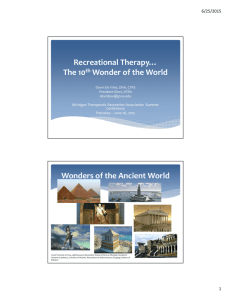

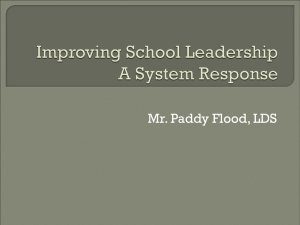
![[Share-My-Toys Membership] Marketing Plan](http://s2.studylib.net/store/data/005475303_1-5c5fcecf250fc9c92c1a18cc8f242409-300x300.png)
